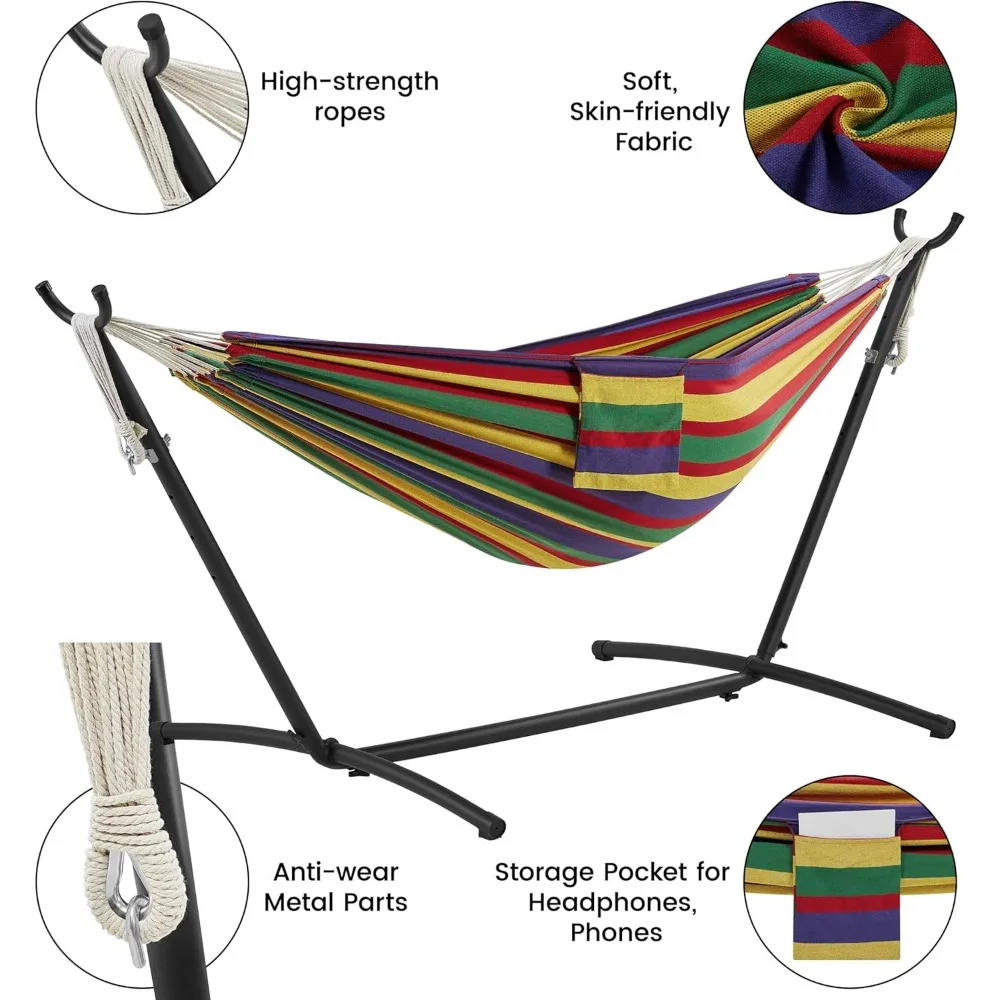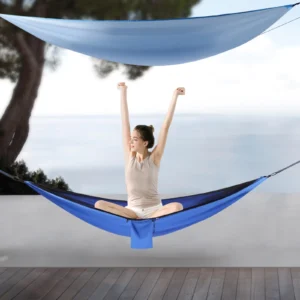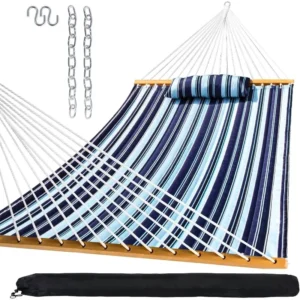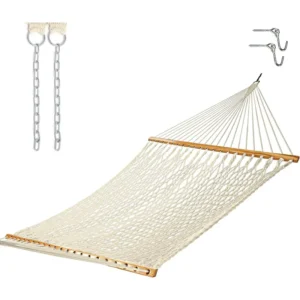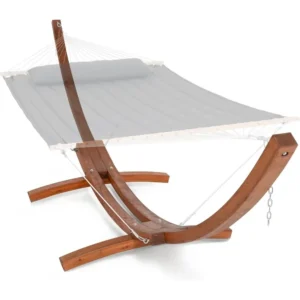Introduction: Why Your Hammock’s Fabric Matters More Than You Think
When it comes to outdoor relaxation, few things compare to the gentle sway of a hammock. However, not all hammocks are created equal, and the fabric choice makes a tremendous difference in your experience. The material directly impacts how comfortable you’ll feel, how long your hammock will last, and how it will hold up against rain, sun, and other outdoor elements.
Unlike traditional rope or net hammocks that leave impression marks on your skin, fabric hammocks provide a smooth, continuous surface that cradles your body. The right fabric can transform a simple afternoon nap into a luxurious escape, while the wrong choice might leave you with a soggy, moldy mess after the first rainstorm.
Weather conditions play a crucial role in determining which fabric will serve you best. A hammock that performs beautifully in dry, moderate climates might deteriorate quickly in tropical humidity or harsh sun exposure. Understanding these differences helps you make a smart investment that matches your specific environment and usage patterns.
Considering how and where you’ll use your hammock is essential for indoor-outdoor hammock placement decisions and will guide your fabric selection. Whether you plan to leave it outdoors permanently or bring it in after each use will significantly impact which material offers the best value for your lifestyle.
For quality options that match various needs, exploring dedicated fabric hammock sets can provide a good starting point for your selection journey.
Understanding Essential Characteristics of Outdoor Hammock Fabrics
Durability
The durability of hammock fabric determines how long your investment will last and how much weight it can safely support. Tension strength refers to how well the fabric withstands the pulling forces when you lie in it. Look for fabrics with high denier ratings (the measurement of fiber thickness) for greater strength. Quality hammocks typically feature reinforced stitching at stress points to prevent tearing even with regular use.
Weather Resistance
UV Protection and Fade Resistance
Constant sun exposure can quickly degrade inferior fabrics. Premium outdoor hammocks use solution-dyed fabrics where color is added during fiber creation rather than applied to the surface afterward. This process creates color that extends throughout the material, preventing surface fading and deterioration from ultraviolet rays.
Water Resistance Capabilities
How a fabric handles moisture significantly impacts its outdoor performance. Some materials naturally repel water, while others absorb it. Water-resistant treatments can be applied to naturally absorbent fabrics like cotton, but these treatments typically wear off over time. Synthetic fabrics often feature inherent water-repelling properties that last much longer.
Mold and Mildew Prevention
Persistent dampness creates the perfect environment for mold and mildew growth. Fabrics with quick-drying properties and those containing antimicrobial treatments help prevent these issues. Understanding whether it’s okay to leave your hammock outside depends largely on the fabric’s resistance to these problems.
Comfort Factors
Comfort involves several elements: the softness against your skin, how well the fabric breathes in hot weather, texture sensation, and how the material conforms to your body shape. Some fabrics feel cool and slick, while others offer a warmer, cozier touch. The ideal choice balances comfort with practical considerations like durability and weather resistance.
Maintenance Requirements
Different fabrics demand varying levels of care. Some require regular washing and special treatments, while others need little more than an occasional rinse with the garden hose. Storage needs also vary—some fabrics must be completely dry before storage to prevent damage, while others are more forgiving.
For those interested in maximizing their hammock’s lifespan, exploring the ultimate guide to fabric hammock durability provides valuable insights on extending your hammock’s service life through proper material selection and care.
Cotton Hammocks: Natural Comfort with Special Considerations
Cotton remains a popular choice for hammocks due to its unmatched natural comfort. The soft, breathable fibers create a cozy embrace that synthetic materials struggle to replicate. Traditional cotton hammocks often use thick, rope-like twisted cotton that becomes increasingly comfortable with use as the fibers soften and conform to your body.
However, cotton’s natural origins come with significant limitations for outdoor use. The material absorbs moisture readily, making it slow to dry and susceptible to mold and mildew growth. When wet, cotton hammocks become heavy and may develop an unpleasant odor if not dried properly.
For maintenance, cotton hammocks typically require more frequent cleaning and should be stored indoors when not in use. Most cotton hammocks benefit from gentle machine washing with mild detergent, followed by thorough air drying before storage or reuse.
Cotton hammocks work best in protected outdoor spaces like covered porches or fair-weather settings where they can be brought indoors during inclement weather. They’re ideal for users who prioritize natural materials and exceptional comfort over weather resistance.
Pros and Cons of Cotton Hammocks
| Pros | Cons |
|---|---|
| Exceptional softness against skin | Poor water resistance |
| High breathability in hot weather | Susceptible to mold and mildew |
| Natural, eco-friendly material | Requires frequent maintenance |
| Conforming feel that improves with use | Fades when exposed to sunlight |
| Generally affordable | Long drying time after getting wet |
For those who enjoy sharing relaxation time, double two-person hammock sets often include cotton options that provide ample space for couples or friends to lounge together.
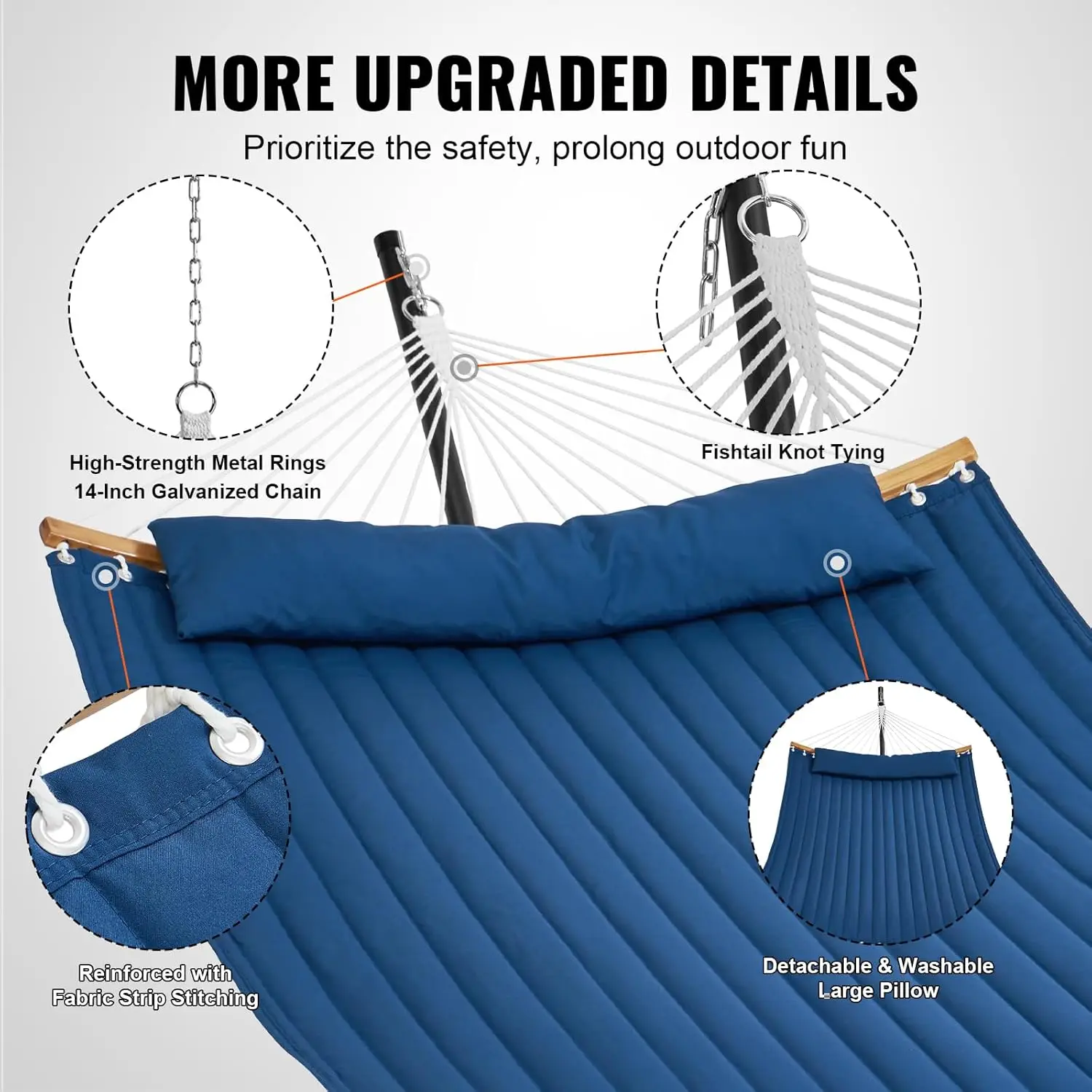
Polyester Hammocks: Versatile All-Weather Performance
Polyester has become a go-to material for outdoor hammocks thanks to its impressive balance of performance characteristics and reasonable price point. As a synthetic fiber, polyester offers significant advantages over natural materials for outdoor applications.
The fabric’s tight weave creates a strong surface that resists tearing and maintains its shape even after extended use. Quality polyester hammocks typically maintain their tension without the excessive stretching that can happen with natural fibers. This stability helps ensure consistent comfort and proper hanging height throughout years of use.
Weather performance is where polyester truly shines compared to cotton. The material offers excellent UV resistance, maintaining its color and structural integrity even after seasons of sun exposure. Water beads up on properly treated polyester rather than soaking in, allowing for quick drying after rain or morning dew. This quick-drying capability (typically 1-3 hours in sunny conditions versus 8+ for cotton) significantly reduces the risk of mildew and mold development.
Care requirements for polyester hammocks are minimal. Most dirt and debris can be removed with a simple hose rinse, while more stubborn stains typically respond well to gentle scrubbing with mild soap and water. The material can be left outdoors for extended periods without suffering major damage, though storage during severe weather is still recommended.
Selecting the best indoor-outdoor hammock locations becomes easier with polyester options since they can handle various environmental conditions with minimal special care.
Pros and Cons of Polyester Hammocks
| Pros | Cons |
|---|---|
| Excellent UV resistance | Less breathable than cotton |
| Good water repellency | Can feel synthetic/less natural |
| Quick-drying capabilities | Moderate rather than premium comfort |
| Minimal stretching over time | May generate static electricity |
| Wide range of color options | Less environmentally friendly production |
| Moderate price point |
Olefin (Polypropylene) Hammocks: Superior Weather Performance
Olefin, also known as polypropylene, represents a significant step up in weather performance for outdoor hammocks. This synthetic material is created through solution-dyeing, where color is added to the molten polymer before the fiber is formed. This process makes the color an integral part of the fiber rather than a surface treatment, resulting in exceptional fade resistance even under intense sun exposure.
The molecular structure of olefin creates inherent water repellency without additional chemical treatments. Water simply rolls off the surface rather than being absorbed, allowing these hammocks to dry extremely quickly after rain. This natural water resistance, combined with the material’s resistance to bacterial growth, makes olefin hammocks particularly well-suited for poolside use or humid environments.
Environmental benefits distinguish olefin from many other synthetic options. The manufacturing process requires less energy and fewer chemicals than most synthetic alternatives. Additionally, olefin is 100% recyclable and produces no harmful byproducts when properly recycled, making it a more eco-friendly synthetic option.
The comfort of olefin hammocks initially feels slightly less soft than cotton but tends to improve with use. The material maintains a comfortable temperature and doesn’t become unbearably hot in direct sunlight like some darker synthetic fabrics might.
For those seeking enhanced comfort features, quilted fabric hammock sets often incorporate olefin in their construction to balance weather performance with softness.
Pros and Cons of Olefin Hammocks
| Pros | Cons |
|---|---|
| Exceptional fade resistance | Moderate initial comfort (improves with use) |
| Superior water repellency | Higher cost than basic synthetics |
| Excellent mold resistance | Limited insulation in cooler weather |
| Lightweight construction | Less traditional feel than natural fibers |
| Environmentally friendly production |
Premium Acrylic Hammocks: The Ultimate in Outdoor Fabric
Acrylic fabric represents the pinnacle of outdoor hammock materials, offering an unmatched combination of comfort, durability, and weather performance. Premium brands like Sunbrella® have established acrylic as the gold standard for high-end outdoor applications from boat covers to luxury patio furniture.
The solution-dyeing process used for acrylic fabrics involves adding color pigments to the liquid acrylic solution before it’s extruded into fibers. This creates color that permeates the entire fiber rather than just coating the surface. The result is extraordinary fade resistance, with quality acrylic hammocks maintaining their vibrant appearance for 5+ years even with continuous outdoor exposure—a performance level unmatched by other materials.
What sets premium acrylic apart from other synthetics is its remarkable softness and cotton-like feel without sacrificing weather performance. The fabric breathes well in hot weather while still providing some insulation during cooler evenings. This versatility makes it suitable for a wide range of climates and seasons.
In extreme weather conditions, acrylic demonstrates superior resilience. The fabric resists mildew, mold, and bacteria naturally while maintaining dimensional stability even after years of use. Many manufacturers offer 5-10 year warranties on premium acrylic hammocks, reflecting their confidence in the material’s longevity.
For those seeking the most durable and comfortable options, heavy-duty hammock sets frequently feature premium acrylic construction to ensure years of reliable service.
Pros and Cons of Premium Acrylic Hammocks
| Pros | Cons |
|---|---|
| Luxurious, cotton-like feel | Premium price point |
| Exceptional fade resistance (5+ years) | Slightly heavier than some alternatives |
| Superior durability and longevity | May require specialized cleaning for tough stains |
| Excellent breathability | Higher initial investment |
| Minimal maintenance requirements |
Nylon Hammocks: Lightweight Solutions for Portability
Nylon hammocks occupy a specialized niche in the outdoor relaxation world, prioritizing lightweight performance and portability over lounge-style comfort. Originally developed for the camping and backpacking markets, these hammocks have gained popularity for their impressive strength-to-weight ratio and packability.
The most common variants include parachute nylon (named for its similarity to parachute material) and ripstop nylon, which features a reinforced weave pattern that prevents small tears from expanding. These materials typically feature denier ratings between 40D and 70D, balancing durability with minimal weight. A complete nylon hammock system often weighs less than a pound yet can support 300-400 pounds safely.
Drying speed is another significant advantage of nylon hammocks. When caught in a rainstorm, these hammocks can dry completely in as little as 15-30 minutes in sunny conditions, compared to hours for other materials. This quick-drying property makes them ideal for multi-day outdoor adventures where extended dampness would be problematic.
However, nylon hammocks make compromises for their portability. The slick, thin material doesn’t provide the same cradling comfort as fabric hammocks designed primarily for lounging. The material can feel uncomfortably cool in breezy conditions and may create a “wrapped” sensation that some users find claustrophobic during extended use.
For adventurers who prioritize mobility, our ultralight camping hammock sets offer optimized nylon options designed to minimize pack weight without sacrificing essential performance.
Pros and Cons of Nylon Hammocks
| Pros | Cons |
|---|---|
| Extremely lightweight construction | Less comfortable for extended lounging |
| Highest strength-to-weight ratio | Less breathable in hot weather |
| Very quick-drying capabilities | Potential for slipperiness when moving |
| Compact storage size | Thinner feel against body |
| Typically affordable price point | Limited insulation in cooler conditions |
Specialized Hammock Designs: Beyond Basic Fabrics
While the base fabric forms the foundation of a hammock’s performance, specialized designs and construction techniques can significantly enhance comfort, durability, and functionality. These advanced features address specific needs and often combine multiple materials to achieve performance beyond what any single fabric could provide.
Quilted Hammocks
Quilted hammocks feature multiple fabric layers with batting or filling material sandwiched between them. This construction creates a padded surface that:
* Provides insulation for cooler weather use
* Reduces pressure points for enhanced comfort
* Adds structure that prevents excessive wrapping around the body
* Creates a more bed-like lying surface
The filling materials range from synthetic polyester batting to natural cotton, each offering different levels of loft and insulation. Premium quilted hammocks often feature weather-resistant outer layers with softer, comfort-focused inner fabrics.
Padded Options
Beyond traditional quilting, some hammocks incorporate:
* Memory foam inserts for pressure point relief
* Integrated pillows for head and neck support
* Structured side bolsters that prevent excessive rolling
* Zoned padding that targets common pressure areas
These enhanced comfort features particularly benefit users with back sensitivity or those planning extended lounging sessions.
Quick-Drying Technologies
Advanced hammocks employ specialized fabric technologies to enhance drying speed:
* Multi-layer wicking systems that pull moisture away from the body
* Mesh drainage panels that prevent water pooling
* Hydrophobic thread treatments that complement water-resistant fabrics
* Ventilation channels that promote airflow through padded sections
Understanding Denier Count
Fabric strength correlates directly with denier count—the measurement of fiber thickness:
* Lower denier (20-40D): Lightweight but requires careful handling
* Medium denier (70-210D): Good balance of weight and durability
* High denier (400D+): Extremely durable but heavier overall
For hammocks with unique structural elements, our spreader bar hammock sets demonstrate how specialized design components can enhance the performance of various fabric types.
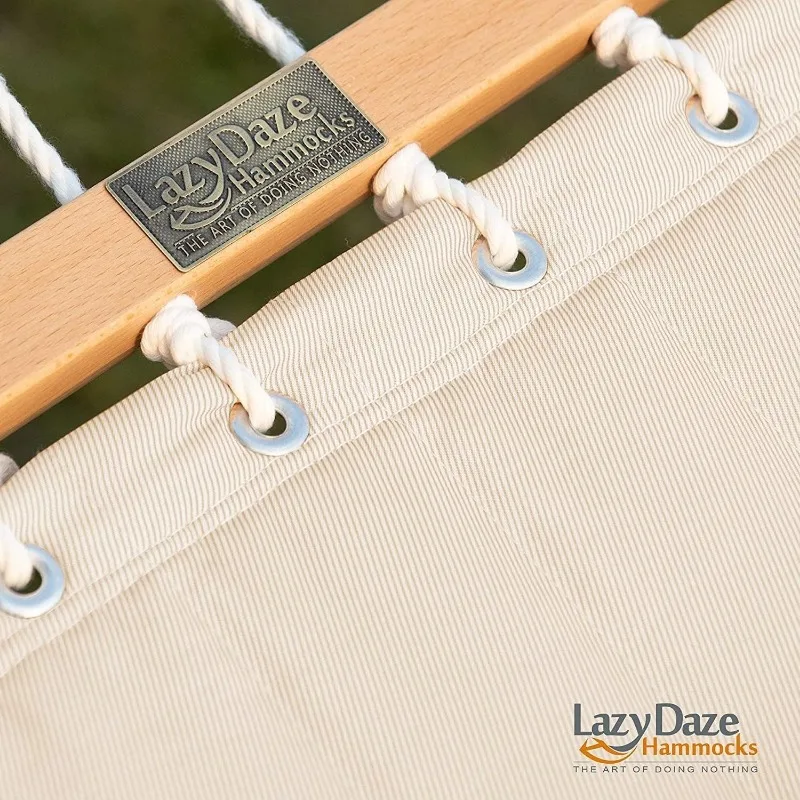
How to Choose the Perfect Outdoor Fabric Hammock
Selecting the ideal hammock requires evaluating your specific needs against the strengths and limitations of different fabric options. This decision-making framework helps navigate the many choices available:
Climate Assessment
Match your local weather patterns to appropriate fabric properties:
* Hot, humid environments: Prioritize mildew resistance and breathability (acrylic, olefin)
* Rainy regions: Emphasize quick-drying capabilities and water resistance (polyester, olefin, nylon)
* High-UV exposure areas: Focus on fade resistance and UV stability (acrylic, olefin)
* Seasonal use: Consider storage requirements during off-seasons
Usage Patterns
How and how often you’ll use your hammock should influence your choice:
* Daily use: Invest in higher durability materials that withstand constant use
* Occasional weekend lounging: Balance comfort with reasonable weather resistance
* Travel and portability needs: Consider weight and packed size (nylon)
* Year-round vs. seasonal use: Evaluate weather performance requirements accordingly
Comfort Priorities
Personal preferences vary significantly:
* Soft, natural feel: Cotton or premium acrylic offer the most pleasant touch
* Supportive structure: Look for quilted options with appropriate filling
* Temperature preferences: Consider breathability for hot climates or insulation for cooler settings
* Body contouring: Some fabrics cradle the body more naturally than others
Maintenance Willingness
Be realistic about the care you’re willing to provide:
* Minimal maintenance: Premium acrylic or olefin require little ongoing care
* Moderate care: Polyester requires occasional cleaning but resists most issues
* High maintenance: Cotton demands regular attention to prevent problems
* Storage capabilities: Consider whether you have appropriate off-season storage space
For additional guidance tailored to various situations and preferences, our guide on choosing the perfect outdoor fabric hammock provides detailed scenarios and recommendations.
Budget Considerations
Price ranges vary widely across hammock materials:
* Entry-level: Cotton and basic polyester ($50-150)
* Mid-range: Quality polyester and olefin ($150-300)
* Premium: Acrylic and specialized designs ($300-500+)
Consider long-term value rather than just initial cost—premium materials often deliver many additional years of service, making them more economical over time despite higher upfront costs.
Essential Care Tips for Maximizing Your Hammock’s Lifespan
Proper maintenance significantly extends your hammock’s useful life and maintains its appearance and comfort. These care guidelines help protect your investment:
Regular Cleaning
Establish a cleaning routine based on your hammock’s material:
Cotton Hammocks:
* Hand wash or gentle machine cycle with mild detergent
* Avoid bleach or harsh chemicals that damage fibers
* Air dry completely before storage or reuse
* Address stains immediately to prevent setting
Polyester and Nylon Hammocks:
* Rinse with garden hose to remove surface dirt
* Spot clean stains with mild soap and soft brush
* Rinse thoroughly to remove all soap residue
* Allow to air dry completely
Acrylic and Olefin Hammocks:
* Brush off loose dirt and debris regularly
* Clean with mild soap and water solution for general cleaning
* For tough stains, use diluted bleach solution (only on solution-dyed acrylics)
* Rinse thoroughly and allow to dry completely
Proper Drying
Preventing mold and mildew requires thorough drying:
* Never store any hammock while damp
* Hang in sunlight when possible to speed drying and provide UV sanitization
* Ensure air circulation around all surfaces
* For quilted hammocks, allow extra drying time for internal layers
Seasonal Storage
When not in use for extended periods:
* Clean thoroughly before storage
* Ensure 100% dryness to prevent mold growth
* Store in breathable bags rather than plastic containers
* Choose cool, dry storage locations away from pests
* Fold loosely rather than tightly compressing
UV Protection Strategies
Minimize sun damage with these practices:
* Consider removable shade structures above permanent hammocks
* Apply fabric UV protectant sprays (appropriate for specific materials)
* Rotate hammock positioning to ensure even wear
* Store indoors or under cover when not in use for extended periods
Understanding proper hammock installation requirements and safety guidelines includes maintenance best practices that ensure both safety and longevity.
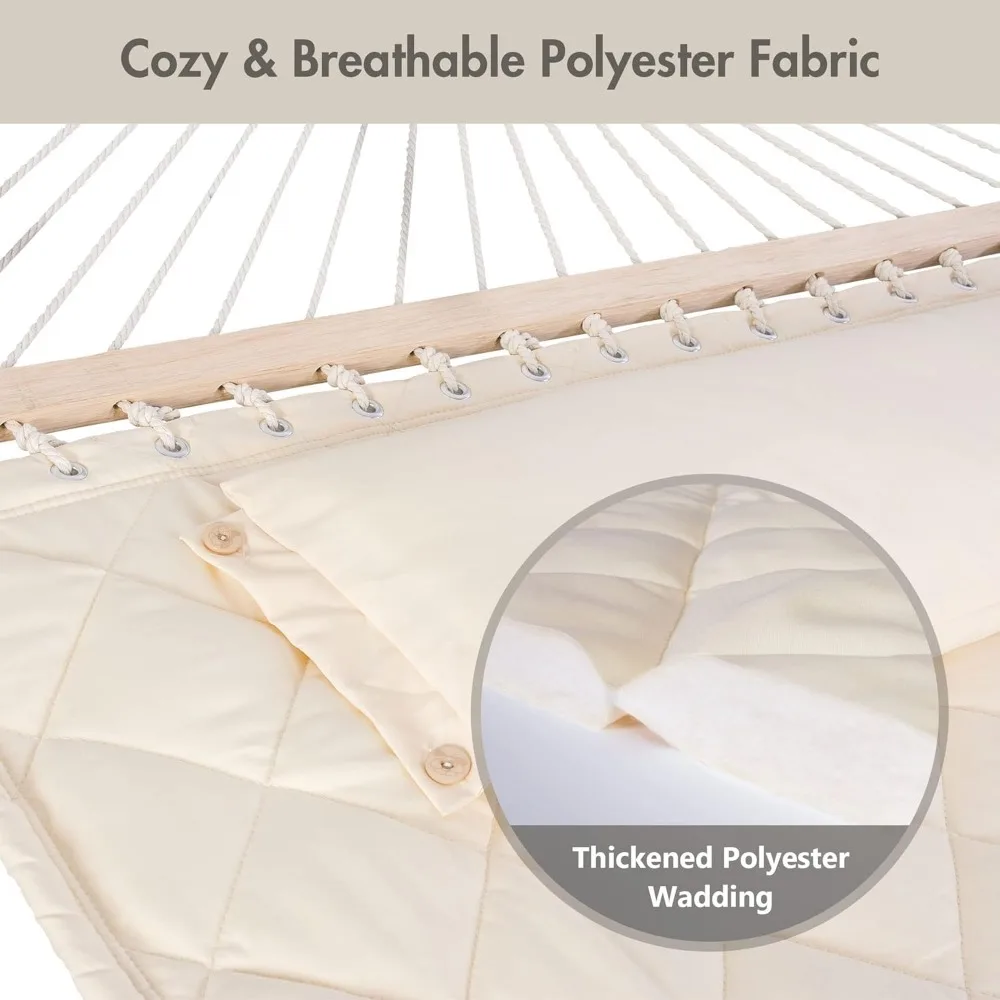
Camping Hammock Sets with Bug Net, Ultralight Camping Hammock Sets
$139.72 Select options This product has multiple variants. The options may be chosen on the product pageClassic Wooden Stand Hammock Sets, Heavy Duty Hammock Sets
$1,061.68 Select options This product has multiple variants. The options may be chosen on the product pageHammock Sets with Canopy, Heavy Duty Hammock Sets
$286.31 Select options This product has multiple variants. The options may be chosen on the product pageDouble / Two Person Hammock Sets, Rope Hammock Sets
Double Traditional Cotton Rope Hammock with Extension Chains – 450 lbs Capacity for Backyard & Patio$292.98 Select options This product has multiple variants. The options may be chosen on the product pageHeavy Duty Hammock Sets, Wooden Arc Stand Hammock Sets
$878.66 Select options This product has multiple variants. The options may be chosen on the product page
Frequently Asked Questions About Outdoor Fabric Hammocks
How long will different fabric hammocks typically last?
With proper care, hammock lifespans vary significantly by material:
* Cotton: 2-5 years with regular outdoor use
* Standard polyester: 3-7 years in moderate conditions
* Quality olefin: 5-8 years with normal exposure
* Premium acrylic: 7-10+ years even with continuous outdoor use
* Nylon: 2-6 years depending on usage intensity
Regular maintenance significantly extends these timeframes, while neglect or harsh conditions reduce them.
Can I leave my fabric hammock outdoors year-round?
This depends entirely on the fabric type:
* Cotton: Not recommended for extended outdoor exposure
* Polyester: Possible in mild climates with occasional maintenance
* Olefin: Suitable for extended outdoor placement in most climates
* Premium acrylic: Best option for permanent outdoor installation
* Nylon: Not recommended for permanent setup due to UV degradation
Even with weather-resistant materials, using a protective cover during extreme weather or extended periods of non-use helps extend lifespan.
Which fabrics are best for extremely humid environments?
For high-humidity locations, prioritize:
* Olefin: Outstanding mildew resistance and quick-drying capabilities
* Premium acrylic: Natural resistance to mold/mildew growth
* Polyester: Good performer with proper drainage and occasional cleaning
* Nylon: Quick-drying but requires UV protection
Avoid cotton in extremely humid environments unless you’re committed to frequent maintenance.
What’s the ideal fabric for poolside use?
Poolside hammocks face chlorine exposure and constant moisture, making certain fabrics superior:
* Olefin: Best overall performance with chlorine resistance and quick drying
* Premium acrylic: Excellent chlorine resistance and comfort
* Marine-grade polyester: Specifically designed for water exposure
Look for fabrics explicitly rated for marine or poolside use for best results.
How do I properly remove mold or mildew?
For most synthetic fabrics:
1. Create solution of 1 cup bleach and 1/4 cup mild soap per gallon of water
2. Apply to affected areas with soft brush
3. Allow to sit 15 minutes
4. Rinse thoroughly
5. Air dry completely in sunlight if possible
For cotton (avoid bleach):
1. Use vinegar-water solution (1:4 ratio)
2. Scrub gently with soft brush
3. Rinse thoroughly
4. Dry in direct sunlight
Are quilted hammocks suitable for rainy climates?
Quilted hammocks require special consideration in rainy areas:
* Choose quilted options with synthetic fillings that resist moisture absorption
* Look for quick-drying outer fabrics like olefin or polyester
* Ensure proper drainage in the hanging position
* Allow extra drying time after rain exposure
* Consider removable quilted pads that can be brought indoors during wet periods
Understanding fabric hammock weight capacity helps you select appropriate materials that maintain structural integrity even when supporting maximum weight.

